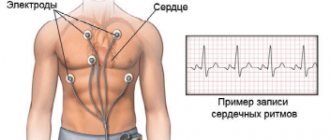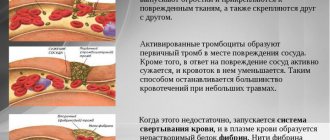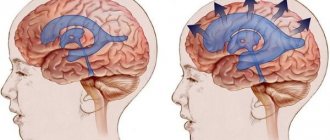The human cardiovascular system is constantly exposed to the negative influence of external factors. With age, the walls of blood vessels weaken, blood circulation is impaired, which can cause serious complications, including death. One of the most common pathologies of the vascular bed is thrombophlebitis. How dangerous is he? Is it possible to cope with the pathology without surgery? Are there preventive measures to prevent the development of pathology? Let's figure out what you need to do to stay healthy.
What is thrombophlebitis
Thrombophlebitis is an inflammation of the venous wall with the formation of a blood clot in the lumen of the vein.
Most often, thrombophlebitis occurs in the veins of the lower extremities, but in some cases it can be localized in the veins of the upper extremities, chest, and neck. Experts usually call inflammation and thrombosis of the superficial saphenous veins thrombophlebitis. In the case of deep vein thrombosis, another term is more often used - “ phlebothrombosis ”.
In the case of inflammation of the vascular wall, in the absence of a blood clot in the lumen of the vein, the term “ phlebitis ” is used.
Causes of thrombophlebitis
The main causes of venous thrombosis:
- inflammatory process (local and/or general),
- slowing down the flow of blood through the venous vessels, leading to venous stagnation (for example, due to varicose veins),
- hereditary or acquired tendency of the blood to form blood clots (coagulopathies or thrombophilic conditions),
- damage to the venous wall (sometimes even minor trauma to the vessel, for example, catheterization of a vein).
Symptoms of thrombophlebitis
- soreness,
- the appearance of local swelling of the limb,
- temperature rise,
- thickening and redness along the affected vein.
In the case of thrombophlebitis of the superficial veins, the patient may notice a gradual increase in the intensity of the changes described above over several days.
If you have these symptoms, you should definitely consult a specialist.
However, with deep vein thrombosis (phlebothrombosis), the main symptom is most often swelling of the affected limb, although it should be remembered that many patients with this form of the disease may not have any symptoms for a long time.
If swelling and pain are severe, and are also accompanied by high fever or shortness of breath with coughing attacks or chest pain, it is necessary to call an ambulance team.
These symptoms may indicate the development of deep vein thrombosis, which significantly increases the likelihood of a blood clot breaking off and migrating into the vessels of the lungs.
Home Recipes for Treating Thrombosis
There are proven folk remedies for the treatment of thrombophlebitis. The most common method is compresses:
- With honey. Apply slightly heated natural honey to a gauze bandage, wrap the leg in the problem area, secure the compress with a thick cloth, and leave for 2-3 hours. Do this for 3 days, after which increase the time of application of the compress to 6-8 hours a day.
- With wormwood. You need to crush a bunch of fresh flowers in a mortar and mix with thick sour milk. The proportion is approximately half. The mass should turn out mushy. Apply a tablespoon of the product to gauze, apply to the affected area, secure and leave for 1.5-2 hours. Repeat the procedure daily for 3-4 weeks.
- With Kalanchoe leaves and vodka. Grind 100g of the plant, pour in 500ml of vodka, pour the solution into a closed container and place in a dark place for a week. The liquid should be shaken once a day. Then strain the product and rub it on your legs every day from the foot to the thigh. The course of treatment is 1 month.
- With cabbage. Take a large leaf of white cabbage and apply vegetable oil to the side that you will apply to your leg. Fix the sheet to the affected area with gauze or soft cloth and leave for 6-7 hours. Repeat the procedure daily for a month.
- With tomatoes. Grind red tomatoes to a pulp, apply to gauze and apply to the problem area. Secure the compress with a cloth and leave for 2-3 hours. Repeat the procedure twice a day for 2 weeks.
Treatment of thrombophlebitis with folk remedies is also possible using solutions for internal use:
- With hops. Pour 1 tablespoon of pine cones with a glass of boiling water and heat in a water bath for 15 minutes. You need to take the solution twice a day, half a glass - after waking up and before going to bed.
- With the root of the field steelweed. 30g of crushed roots need to be poured into 400ml of water and boiled for 15 minutes. Then you need to let the solution brew for half an hour and strain. Take half a glass three times a day before meals.
- With nettles. 3 tablespoons of crushed leaves need to be poured into 500 ml of water, boiled, allowed to brew and strain. Take 100 ml three times a day an hour after meals.
Risk factors for the development of thrombophlebitis
- pregnancy, childbirth, gynecological operations (including abortions).
- varicose veins;
- prolonged bed rest (for example, after surgical and orthopedic operations);
- infectious diseases;
- stroke leading to paralysis of the limbs;
- motionless body position during a long trip by car or plane;
- obesity;
- oncological diseases (including surgical treatment of malignant neoplasms, radiation therapy and chemotherapy);
- dehydration;
- the use of hormonal contraceptives and other sex hormone preparations for the purpose of replacement therapy;
- increased blood clotting (hyperhomocysteinemia, antiphospholipid syndrome, etc.);
- puncture and/or venous catheterization.
The more risk factors a patient has, the higher the risk of developing thrombophlebitis.
If you have one or more factors from the above list, consult a specialist about methods of preventing venous thrombosis.
Prevention of thrombophlebitis
Treatment of thrombophlebitis with folk remedies will help eliminate the unpleasant symptoms of the disease and normalize the condition of the vascular bed in the affected area. However, do not forget about preventive measures. The disease will quickly return if the following recommendations are not followed:
- It is necessary to give up bad habits. Drinking alcoholic beverages and smoking negatively affect the body, especially the cardiovascular and respiratory systems.
- The optimal temperature regime for the lower extremities should be ensured - no overheating/hypothermia.
- If you have a sedentary job, you need to do exercises every hour. This will help prevent blood stagnation in the vascular bed.
- During the warm season, you should avoid excessive exposure of your feet to direct sunlight.
There are also traditional methods of preventing the disease. The most effective remedy is herbs for thrombophlebitis. You can take tinctures of verbena officinalis, St. John's wort, string, plantain, broom, hazelnut leaves, licorice root. It is also necessary to follow the basic principles of proper nutrition:
- the basis of the diet is fresh vegetables and fruits, cereals, low-fat dairy products, nuts, lean meat and fish;
- drinking enough water during the day – at least 1.5 liters;
- eating small portions 5-6 times a day.
If you have thrombophlebitis, you should completely exclude the following foods from your diet:
- sausages, semi-finished products;
- confectionery, sweets;
- fatty meat, pork liver, soy products;
- all varieties of cabbage;
- legumes (beans, lentils, peas);
- bananas and black currants.
In order to cope with pathology without surgery, an integrated approach is required. Lead a healthy lifestyle, eat right, use the above-mentioned folk remedies, and regularly visit your doctor to monitor the disease.
Confirmation of the diagnosis of thrombophlebitis
During the examination, the specialist individually selects the required minimum of research for each specific case. To confirm or exclude thrombophlebitis of the lower extremities, your doctor may choose one of the following diagnostic methods:
- Blood tests (clinical blood test, coagulogram, D-dimer);
- Venography (X-ray examination of the venous bed using the injection of a contrast agent that stains the vessels from the inside). Currently, due to the development of low-traumatic and highly informative research methods (primarily duplex angioscanning), it is used extremely rarely;
- Computed tomography and magnetic resonance imaging in vascular mode - performed in situations where ultrasound diagnostic methods are not very informative;
- Ultrasound diagnostic methods (Dopplerography and duplex angioscanning) are currently the “gold standard” for diagnosing thrombophlebitis.
After a diagnosis has been established, you may need additional diagnostics to identify the causes of thrombophlebitis, as well as control studies to clarify the nature of the dynamics of the pathological process.
What thins the blood?
After 30–35 years, even in a healthy person, blood density increases. The following factors lead to this:
- Unbalanced diet, smoking, alcohol, lack of vitamins.
- Violation of the water regime, insufficient drinking or consumption of low-quality tap water.
- Taking certain medications, primarily diuretics.
Some diseases of the kidneys, liver, even viral infections are accompanied by changes in blood density.
What in the functioning of the body should alert and arouse suspicion that not everything is fine with the blood? Pay attention to the following phenomena:
- Tingling or numbness in the extremities.
- Slow flow of blood from cuts. Moreover, it is dark in color.
- Shortness of breath - it is difficult for the heart to pump thick fluid.
- Drowsiness, lethargy, chronic fatigue, which is caused by a lack of oxygen in the cells.
Thick blood is the cause of stroke: WebMD
But the symptoms described can accompany other diseases, so they require confirmation from a doctor. Seek advice from a medical institution and get tested if necessary. The most important of them is to determine the hematocrit level, which will show the density of the blood.
If you do not ask in time how to thin the blood, you can hasten a stroke or heart attack, or the appearance of blood clots. Our foreign colleagues told us on the PubMed website how insidious and unpredictable thrombosis is.
Blood clot can cause heart attack: WebMD
If the case is complex and medical attention is required, then do not self-medicate, which can lead to serious consequences - be sure to consult with your doctor. To maintain optimal blood thickness, practice blood thinning at home in the following ways:
- The simplest one is to drink more water. Discuss with your doctor exactly how much will be useful for you.
- Slight viscosity can be adjusted by diet. Eat blood thinning foods: garlic, flaxseed or olive oil, berries (especially cranberries), orange juice. Lean fish, seafood, chicken and rabbit meat are healthy.
- What other foods thin the blood? These are well-known seasonings: ginger, cinnamon, cayenne pepper, turmeric, oregano, thyme.
- There are also folk remedies for thinning the blood - these are decoctions and tinctures from medicinal plants.
Among other recommendations on how to make blood liquid, I suggest this: before breakfast, roll sunflower oil in your mouth for 10 minutes, then spit it out. This will maintain optimal plasma density, one of the two main components of blood.
If your blood is thick, exclude fatty dairy products, buckwheat, lentils, and foods high in vitamin K (bananas, kiwi, grapes, etc.) from your diet.
Treatment methods for thrombophlebitis
Treatment of thrombophlebitis of superficial veins
In this case, the specialist may recommend treatment on an outpatient basis. The list of recommendations may include medications:
- having an anti-inflammatory effect (non-steroidal anti-inflammatory drugs, for example: Nimesil, Ibuprofen, Diclofenac, Nise, etc.);
- local remedies (compresses and ointments);
- compression methods (elastic bandages or compression hosiery, etc.);
- phlebotonic agents (Detralex, Phlebodia, Antistax, Vasoket, etc.).
With thrombophlebitis of the superficial veins, the patient rarely needs hospitalization and, with proper treatment, as well as careful adherence to medical recommendations, relief usually occurs quickly.
With the progression of superficial thrombophlebitis (growth of the thrombus border), surgical prevention of thromboembolism (separation and migration of thrombotic masses into the vessels of the lungs) and the spread of thrombosis to the deep vein system may be required. Surgical intervention in this case is performed according to urgent indications and most often consists of ligating the thrombosed superficial vein (great or small saphenous vein) at the point where it flows into the deep vein system and, if possible, removing varicose veins (thrombosed and non-thrombosed) veins.
Treatment of deep vein thrombosis
Drug therapy
Injections of blood thinning drugs - anticoagulants (heparin or its modern analogues: Clexane, Fraxiparin, Fragmin). After heparin therapy, long-term use of the tablet form of another blood thinning drug, warfarin, may be prescribed. Treatment with anticoagulants is carried out to prevent the growth of a blood clot and prevent recurrence of venous thrombosis.
If your doctor has prescribed you warfarin, strictly follow the instructions for taking the drug and monitoring your blood clotting.
Warfarin is a powerful drug that can cause a number of dangerous side effects if you do not follow your doctor's instructions.
Compression therapy
The use of elastic bandages and the selection of individual compression hosiery is one of the main tools for therapeutic effects, as well as prevention for deep vein thrombosis. Consult a specialist about possible compression therapy methods in your case.
Implantation of vena cava filter
In some cases, especially if there are contraindications to blood-thinning drugs or their ineffectiveness, a vena cava filter device can be installed in the main vein of the patient's body (inferior vena cava) to prevent the migration of detached fragments of blood clots from the veins of the lower extremities to the vessels of the lungs. The vena cava filter acts as a trap for detached blood clots. The filter can be installed for a certain period of time (3-4 weeks) or permanently. This procedure is most often performed under local anesthesia and does not require a long hospital stay.
Surgery
Thrombectomy, venous angioplasty and venous bypass.
In some cases, it may be necessary to perform a surgical intervention aimed at removing thrombotic masses of large venous trunks (thrombectomy) in the lower extremities, pelvis or abdomen. To treat long-standing blockage, bypass surgery or minimally traumatic intervention (stenting) of the affected segment of the main vein is sometimes performed.
The volume and nature of surgical intervention for deep vein thrombosis is determined individually by the vascular surgeon.
Thrombolysis
Dissolution of thrombotic masses with the help of special drugs - thrombolytics (urokinase, actilise, etc.). This procedure can only be performed in the early stages of the disease and has a number of special contraindications.
Common methods of treating the disease
Treatment measures in case of thrombophlebitis can be:
- Conservative. The patient is prescribed medications for topical use that help resolve blood clots, as well as medications for oral administration that thin the blood.
- Surgical. When the problem becomes rampant, doctors are forced to use radical methods to save the patient’s life. The operation involves complete removal of the vein or excision of thrombosed nodes. If a floating thrombus is detected in a patient during diagnosis, installation of a vena cava filter is indicated.
Diet for thrombophlebitis
A large amount of fresh vegetables, fruits, fiber, nuts, cereals, whole grain breads. Among products of plant origin, the following also have a beneficial effect on venous diseases:
- ginkgo biloba,
- ginger,
- red capsicum,
- valerian root,
- garlic,
- hawthorn berries.
Nutritional supplements and vitamins:
- vitamins C, A, E and B6,
- linseed oil,
- magnesium and calcium (in combination),
- Pycnogenol
Recommendations for changing the lifestyle of patients with thrombophlebitis
- Elevated position of the lower extremities during rest and sleep;
- Avoid prolonged static loads;
- Avoiding heavy physical activity (weight lifting);
- Avoid overheating and dehydration (long stay in the bathhouse);
- Wear compression hosiery of the required compression class (determined by a specialist);
- Limiting static loads (avoid sitting for long periods of time, standing without moving);
- Constant physical activity - walking, swimming, cycling;
- Selection of comfortable shoes and orthopedic insoles.






